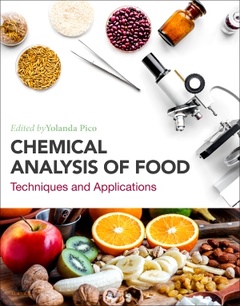Description
Chemical Analysis of Food (2nd Ed.)
Techniques and Applications
Coordinator: Pico Yolanda
Language: English
Subjects for Chemical Analysis of Food:
Keywords
biochemical sensor; capillary electrochromatography; capillary gel electrophoresis; capillary isotachophoresis; capillary zone electrophoresis; cereals; chemometrics; chemometry; classification; comprehensive two-dimensional GC (GC × GC); contaminants; conventional methods; DART/DESI; deep eutectic solvents; direct MS; driving force; electromagnetic spectrum; electronic nose; electronic tongue; environmental contaminants; extraction techniques; filamentous fungi; flavor; fluorescence; food; food allergens; food analysis; food and beverages; food authenticity; food chain; food industry; food safety; Foodomics; foodstuffs; fraud; fruits; gas chromatography; gas chromatography (GC); GC?MS; genetically modified organisms; GMOs; health food; high performance liquid chromatography; high-resolution mass spectrometry (HR-MS); ICP-MS; imaging; imaging techniques; ionic liquids (ILs); LC?MS; legumes; limit of detection; limit of quantification; liquid chromatography; liquid chromatography coupled to gas chromatography (LC?GC); liquid state NMR; magnetic resonance; mass spectrometry; metabolomics; metal speciation; micellar electrokinetic chromatography; microarray; microelectromechanical systems technology (MEMS); microfluidic devices; microplastics; MIR; modelling; MS approaches; multidimensional gas chromatography (MDGC); multivariate data analysis; mycotoxins; nanomaterials; natural toxins; NIR; nontargeted analysis; nutrients; nuts; odor; oilseeds; organophosphorus flame retardants; pattern recognition; PCR; perfluoroalkyl substances; polybrominated flame retardants; proteomics; PTR-MS; quality; Raman; sample preparation; sample pretreatment; sampling; sensors; solid state NMR; spectroscopy; substances formed during food processing; substances migrating from food packaging; tandem ionization; transcriptomics; transgenic food; validation; vegetables
916 p. · 19x23.3 cm · Paperback
Description
/li>Contents
/li>Readership
/li>Biography
/li>Comment
/li>
Chemical Analysis of Food: Techniques and Applications, Second Edition, reviews the latest technologies and challenges in all stages of food analysis, from selecting the right approach, how to perform analytic procedures, and how to measure and report the results. The book is structured in two parts: the first describes the role of the latest developments in analytical and bio-analytical techniques, with the second reviewing innovative applications and issues in food analysis. The techniques discussed range from the non-invasive and non-destructive, such as infrared spectroscopy and ultrasound, to newly emerging areas, such as nanotechnology, biosensors and electronic noses and tongues.
This thoroughly updated edition includes new chapters on ambient mass spectrometry, imaging techniques, omics approaches in food analysis, natural toxins analysis, food contact materials, nanomaterials and organic foods. All chapters are updated or rewritten to bring the content completely up-to-date.
PART I: Chemical Analysis of Food 1. Basics and Advances in Sampling and Sample Preparation 2. Data Analysis and Chemometrics 3. Near-Infrared, Mid-Infrared, and Raman Spectroscopy 4. Nuclear Magnetic Resonance 5. The Applications of nanotechnology 6. Molecular Techniques 7. Microfluidic Devices, Biosensors 8. Electronic Noses and Tongues 9. Liquid Chromatography 10. Gas Chromatography 11. Electrophoresis 12. Mass Spectrometry 13. Ambient Mass Spectrometry 14. Imaging techniques 15. Omics Approaches in Food Analysis
PART II: Applications 16. Traceability 17. Food Authenticity and Fraud 18. Food Proteomics 19. Biologically Active, Health Promoting Food Components 20. Novel Food and Nutritional Supplements 21. Foodomics Evaluation of Genetically Modified Organisms 22. Flavours and Odours 23. Emerging Contaminants 24. Natural Toxins Analysis 25. Allergens 26. Metal speciation 27. Radionuclides 28. Food Contact Materials 29. Nanomaterials 30. Organics foods
Scientists and researchers working in chemistry, biochemistry, biology, food chemistry, toxicology, agronomy, nutrition, food processing and safety, and hygiene who are involved in food analysis
Secondary: Other disciplines interested in food composition and food-related problems, such as nutritionists, food inspectors, food industry, and those involved in food risk assessment and management
Yolanda Pico was born in Valencia, Spain, in 1964. She received her Ph.D. in Pharmacy in 1992, after which she was a post-doctoral fellow at the Vrije Universiteit of Amsterdam (The Netherlands) (1992/1993) and at the “La Sapienza University (Rome, Italy) (1996); Assistant Professor of Nutrition and Bromatology at the University of Valencia (1993-1998). Since 1998 she is full Professor of Nutrition and Food Science at the Department of Preventive Medicine and Public Health, Food Science, Toxicology and Legal Medicine of the University of Valencia and the Head of the research group in Food and Environmental Safety (SAMA-UV). Her research interests include identification of unknown compounds by liquid chromatography-mass spectrometry, microextraction separations and environmental and food safety, development of new analytical methods to determine contaminants in food and the environment and the application of methodologies to the risk assessment of different hazard within both field. She is the author of nearly 240 peer-reviewed papers 180 scientific papers in journals of SCI, 30 book chapters and editor of 3 books on Food and Environmental Safety and Applications of liquid chromatography-mass spectrometry. She has a hirsh index of 47 has been a member of various international scientific committees of renowned institutions. Other relevant activities include the following: Member of the Scientific Panel of Plant Protection Products and their Residues (PPR Panel) of the European Food Safety Authority (EFSA) (2009-2012) and partner of projects related with food, water and soil quality at the different national and international levels. She has been supervising 9 Ph.D. theses on food analysis (1992-2014).
Her main focusses are: risk assessment of the exposure to pesticide residues, veterinary and human medicines, illicit drugs, perfluorinated compounds, and other emerging compounds including toxic-analytical aspects, of bioavailability and bioaccesibility, syne
- Reviews the attributes, benefits, limits and potential of all relevant analytic modalities, including spectroscopy, ultrasound and nanotechnology applications
- Provides in-depth coverage of each technology, including near-infrared, mid-infrared, and Raman spectroscopy, low intensity ultrasound, microfluidic devices and biosensors, electronic noses and tongues, mass spectrometry and molecular techniques
- Outlines practical solutions to challenging problems in food analysis, including how to combine techniques for improved efficacy
- Covers all relevant applications of food analysis, such as traceability, authenticity and fraud, biologically-active food components, novel food and nutritional supplements, flavors and fragrances, and contaminants and allergens
- Provides researchers with a single source of current research and includes contributions from internationally renowned experts in food science and technology and nutrition
These books may interest you

Advances in Food Diagnostics 207.30 €



